Learn to Kitesurf for Beginners : 5 step tutorial
INTERMEDIATE
15 CHAPTERS
ADVANCED
16 CHAPTERS
Kitesurfing is an exciting outdoor activity that can be learnt at any age. If you want to disconnect from everyday life, reconnect with nature and take on a new challenge that's ambitious but achievable in just a few days, then join our kitesurfing schools and learn to kitesurf quickly and safely!
12 hours of lessons
to become Autonomous
- 6 hours of discovery courses
- 6 hours of progression
- VDWS or IKO certification
Beginners aim to reach a level of autonomy that will lead them to the title of ‘intermediate’. This level is generally sanctioned by an IKO 2 certification (cf. International Kitesurf Organisation nomenclature) or XX from the VDWS (International Training Association For Watersports).
HANDLING THE SAIL
WATER START
PULL EDGES
TO THE LEFT
PULL EDGES
RIGHT
GO UPWIND
TIPS & TRICKS
With this comprehensive guide, you'll be able to prepare to take the steps one by one with just the right amount of anticipation. We'll cover everything from the equipment you need to the different techniques to mastering your goal and becoming a self-sufficient kiteboarder who rides upwind.

Frequently asked questions before getting started?
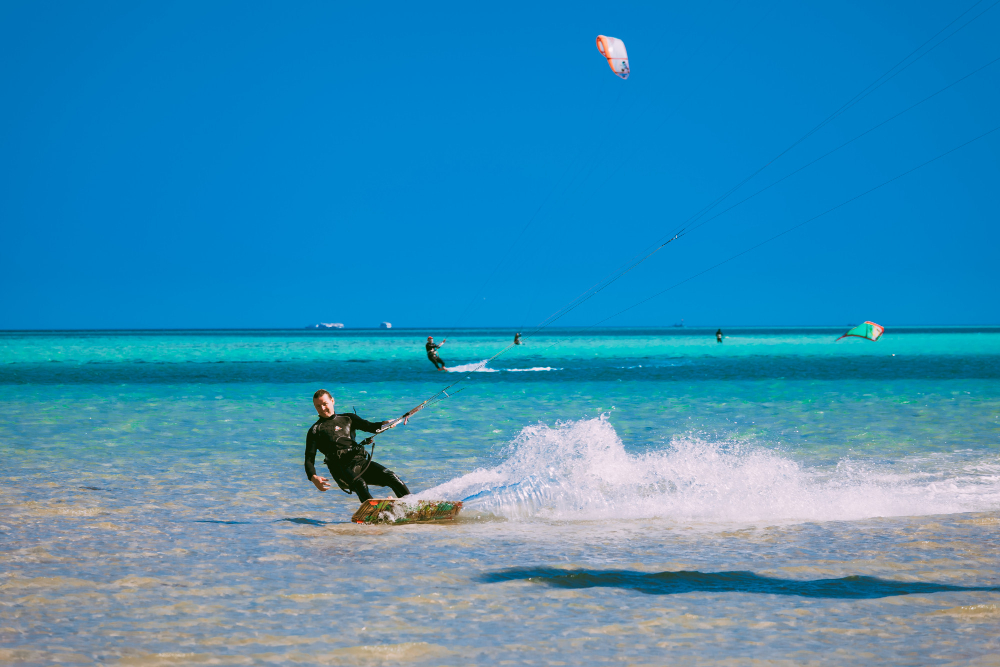
Learning to kitesurf isn't difficult!
Are you keen to start kitesurfing as a family, with friends, as a couple or on your own? Wondering if it's right for you? You need to be in good physical shape, it's a sport you can grow into and it's not physically demanding.
After a kitesurfing session, there's no pain. So you don't need to be a muscular man, which makes kitesurfing particularly suitable for women.
Follow our guide and discover our best kitesurfing schools to learn to kitesurf safely and progress to get the basics and have fun! For all budgets, from France to Morocco in Dakhla, via Spain with Tarifa or the Canary Islands !
Learning to kitesurf on your own: the wrong idea!
It is possible, but not recommended! You need to take into account the gusts of wind and other dangers and parameters of this sport. That's why, from a safety point of view, we strongly advise you to start kitesurfing with lessons in a school. Find out more about our kitesurfing schools in France (Brittany), Spain (Fuerteventura and Tarifa) and Morocco (Dakhla).
We recommend that you take 12 hours of kitesurfing to start with, which will allow you to set yourself objectives such as becoming independent, being able to reach the Waterstart level before being able to consider that you have acquired the basics, before moving on to the next intermediate stage.

Theory and basic techniques
When you're new to kitesurfing, it's important to understand certain theoretical aspects and master the basic techniques. In this introduction, we'll look at Level 0, priorities on the water,basic safety rules and the equipment you need to kitesurf safely.
We'll recommend kitesurfing courses and the essential techniques you'll need to master, such as handling the sail on the beach and the waterstart.
Kitesurfing equipment
Before you begin your kitesurfing adventure, it's important to have the right equipment. Beginners like to start with a bigger board. A waist harness or a seat harness, as the latter are easier to use. A safety strap and knife. A lifejacket that leaves room for your helm. To sum up, here's the equipment you'll need for your first lessons:
- Kite (kite wing)
- Control bar
- Lifeline
- Harness
- Neoprene wetsuit
- Kiteboard
- Life jackets
Priority rules on water
When kitesurfing, it's essential to know and respect the rules of priority on the water. These rules ensure safety and smooth interaction between kitesurfers. By understanding and applying these rules, you are helping to create a harmonious and safe sailing environment.
- The basic rule of priority in kitesurfing is to give way to the person who is riding upwind. If you come across another kiteboarder, make sure you give them enough room to continue upwind without being obstructed.
- When you are sailing upwind, you must also give priority to kiteboarders who are sailing perpendicular to your trajectory. Give them enough space to pass safely in front of you.
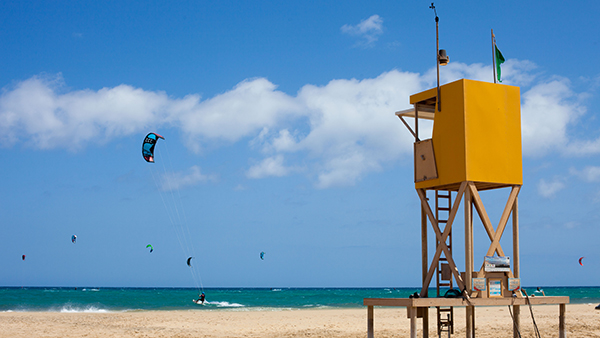
- When approaching the beach, look out for kiteboarders preparing to leave or returning to the beach. Avoid passing too close to them to avoid a collision.
- Beginners and less-experienced riders should pay particular attention to other kiteboarders and give them plenty of space. Be considerate and respect their progress.
- When riding a wave, give way to the person closest to the point where the wave breaks. Avoid riding the same wave as another kiteboarder to avoid collisions.
- In an emergency situation, when you can't avoid an imminent collision, try to let go of the bar to release the kite's power and minimise the risk of injury.
- Be aware of your surroundings and other beach users. Avoid sailing in areas where there is a high density of kiteboarders, and respect local instructions concerning authorised sailing areas.
By respecting the rules of priority on the water, you are helping to ensure that kitesurfing is safe and enjoyable. Be attentive, courteous and considerate towards other kitesurfers and make the most of your experience on the water.
Basic safety rules
Before starting your kitesurfing adventure, it's essential to understand and apply the basic safety rules. These rules will help you to kitesurf responsibly and minimise risk.
Kitesurfing can be a dangerous activity if the safety rules are not followed. It is important to follow your instructor's safety instructions, wear the correct protective equipment and know the emergency procedures in the event of a problem.
It is also important to choose suitable weather and sea conditions for kitesurfing. Avoid days with strong winds or unstable weather conditions.
When kitesurfing, it is important to follow these safety rules to ensure your safety and the safety of others:
- Choose a suitable spot: Make sure you choose a spot suited to your skill level and the weather conditions. Avoid crowded areas and respect local kitesurfing rules.
- Use safety equipment: Always wear a lifejacket and attach your safety leash to your ankle or harness. Make sure you know how to use your safety release so that you can activate it if necessary.
- Practice with a partner: It's a good idea to practice kitesurfing with a partner or to tell someone about your session. That way, if anything goes wrong, you can count on outside help.
- Check the weather conditions: Before you set off, check the weather forecast and be aware of possible changes in wind conditions. Avoid practising in strong winds or in the event of an imminent thunderstorm.
- Respect other beach users: Show courtesy to other beach users. Avoid flying your kite over bathers and swimmers, and leave enough space for other kiteboarders.
- Learn communication signals: Familiarise yourself with the communication signals used between kiteboarders to indicate your intentions or to ask for help. This will make it easier to communicate with other kiteboarders on the water.
- Respect the rules of priority: On the water, it's essential to know the rules of priority. Upwind kiteboarders generally have priority over downwind kiteboarders. Respect these rules to avoid collisions.
By following these basic safety rules, you can kitesurf with confidence and with minimal risk. Always remember that safety is the top priority when practising this exciting sport.

Level 0: The wind window
The wind window is a fundamental concept in kiteboarding that helps kiteboarders understand where and how their kite will fly. The wind window can be imagined as a 180 degree dome or sphere in front of the kiteboarder where the kite can fly.
A kite moves in a quarter sphere in front of it: this is the flight window, sometimes called the wind window. This is the space in which a kite can fly. The wider the flight window (or wind window), the better the kite and the stronger the wind.

This window can be described as follows:
- The horizon in front of the kiteboarder represents the lower edge of the wind window, and this is where the kite has the least power.
- The zenith, directly above the kiteboarder, is the top of the wind window. This is where the kite is most stable, but does not generate much horizontal traction for the kiteboarder.
- The left and right edges of the wind window are called the ‘sides’. This is where the kite generates the most power for horizontal movement, particularly for upwind and downwind.
- The ‘leading edge’ of the wind window is the area between the side and the zenith, where the kite generates considerable but controllable traction.
- The ‘power’ of the wind window is the area where the kite is most powerful and least controllable. It is generally located about 45 degrees above the horizon and in front of the kiteboarder.
Understanding the wind window is essential for controlling the kite, whether it's for making jumps or turns, or simply for sailing efficiently and safely.
Level 1: Sailing on the beach
Before you get on your board, it's important to know how to control your sail properly. You'll need to practise pulling and releasing to understand how the sail reacts. This will help you to familiarise yourself with the controls and to control your sail once on the water.
How to prepare your kite correctly.
Deploy your kite on a clear surface, away from obstacles and other kiteboarders. Make sure the lines are not tangled and that the kite is taut.
- Check that all connections between the lines, control bar and wing are secure. Also check the condition of the lines and bridles for wear and tear.
- Inflate the wing using a suitable pump. Make sure that the wing pressure is within the manufacturer's recommendations.
- Once the wing is inflated, check the connections and settings again. Make sure the lines are tight and not twisted.
- Before attaching yourself to the control bar, make sure that you are well prepared and that you are wearing all the necessary safety equipment, such as a life jacket and helmet.
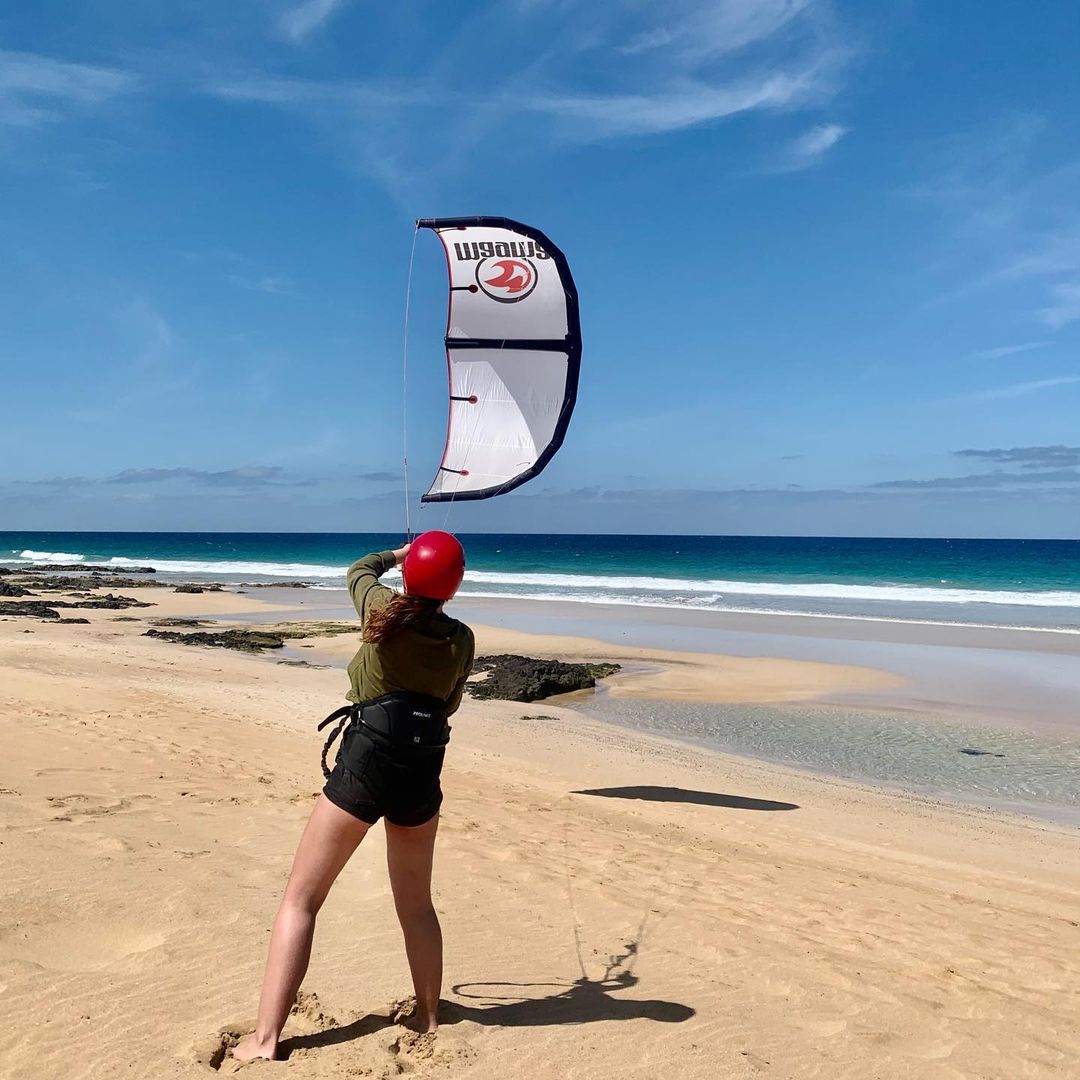
Wing control
Once you've prepared your kite, it's time to learn how to control its power and direction. Mastering control of the kite is essential for safe and confident flying.
- Hold the tiller firmly with both hands and familiarise yourself with the different movements of the tiller to understand how they affect the sail.
- Learn how to use the power controls. Pulling back on the bar increases the wing's power, while releasing it slightly decreases the power. Practise these movements to obtain precise control of power according to wind conditions.
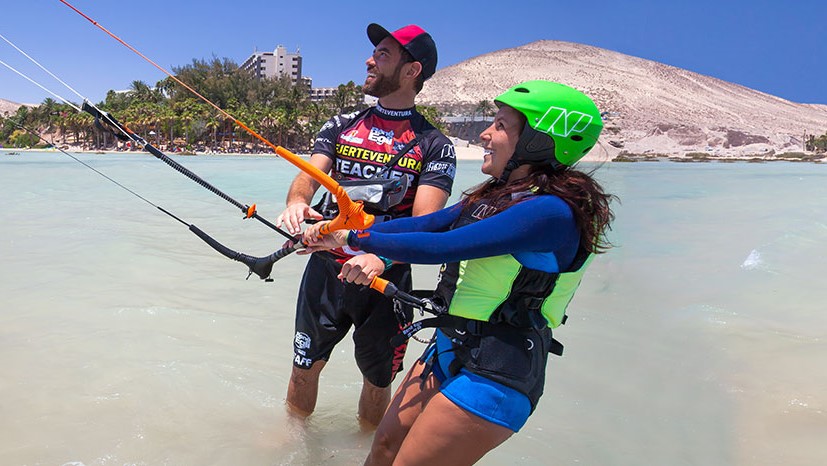
- Practise steering the kite in different directions. Use the movements of the bar to turn the kite left and right, and to keep it in a neutral position. By familiarising yourself with these movements, you'll be able to control the trajectory of your kite.
- Learn to adjust the power of the kite according to the strength of the wind. In strong winds, you should release the power by releasing the bar slightly. In light winds, you'll need to pull a little harder on the bar to increase the power.
- Practise controlling the kite in different situations, such as standing on the beach, in the water or performing manoeuvres. The more you practise, the more you will develop your sense of control and responsiveness.
- By mastering the control of the kite, you'll be able to sail with confidence and in complete safety. Don't forget to always be aware of the wind conditions and follow the safety rules for an enjoyable kitesurfing experience.

Level 2: Waterstart
Once you've understood how to handle the sail, it's time to move on to the next stage: the waterstart. This technique involves getting on your board from the water, using the power of the sail to propel you. It's important to master this technique if you want to move forward safely.

Your first taste of kitesurfing!
Now that you've learned the basics of kite control, it's time to move on to the next stage: standing up on the board and starting to ride. This stage will allow you to feel the first sensations of gliding across the water.
- Choose a longboard suitable for beginners, with good buoyancy and sufficient stability to make learning easier. Also make sure that the fins of the board are well attached.
- Place the board in the water, perpendicular to the beach. Hold the kite firmly with both hands and prepare to set it in motion.
- Use the control of the kite to generate power and start to feel the pull. Keep your knees slightly bent to absorb shock and maintain balance.
- When you feel enough power, gently place one foot on the board, close to the ailerons. Keep the other foot in the water to maintain balance.
- Once you are stable on one foot, slowly place the second foot on the board, keeping a slightly bent position. Continue to control the kite to maintain traction and balance.
- Practise keeping a straight line, using the movements of the bar to adjust the power of the kite. Try to keep a relaxed posture and concentrate on maintaining your balance.
- When you feel comfortable moving forward, try taking a few steps on the board to pick up speed. Remember to look ahead and keep control of the kite throughout the ride.
- By practising regularly, you'll develop your balance, your control of the kite and your ability to ride a longboard. Continue to progress at your own pace and enjoy this exciting stage of kitesurfing.

Level 3: Edge right and left
Now that you've understood the waterstart, it's time to work on your tacking. You'll need to practise tacking left and right to be able to steer and control your direction on the water. This step is crucial to becoming a good kiteboarder.
Piloting with the wing
Now that you've learned the basics of navigating a longboard, it's time to perfect your kite handling. Accurate kite handling is essential for mastering different trajectories and manoeuvres when kitesurfing.
- Learn to fly the kite by using the movements of the bar to change the angle of attack of the kite. By pulling on the bar, the wing will pivot downwards and generate more power. By pushing it, the wing will pivot upwards and release power.
- Practise flying the kite by making left and right turns. Use the movements of the bar to turn the wing in the desired direction. Keep a balanced position on the board and anticipate the kite's reactions.
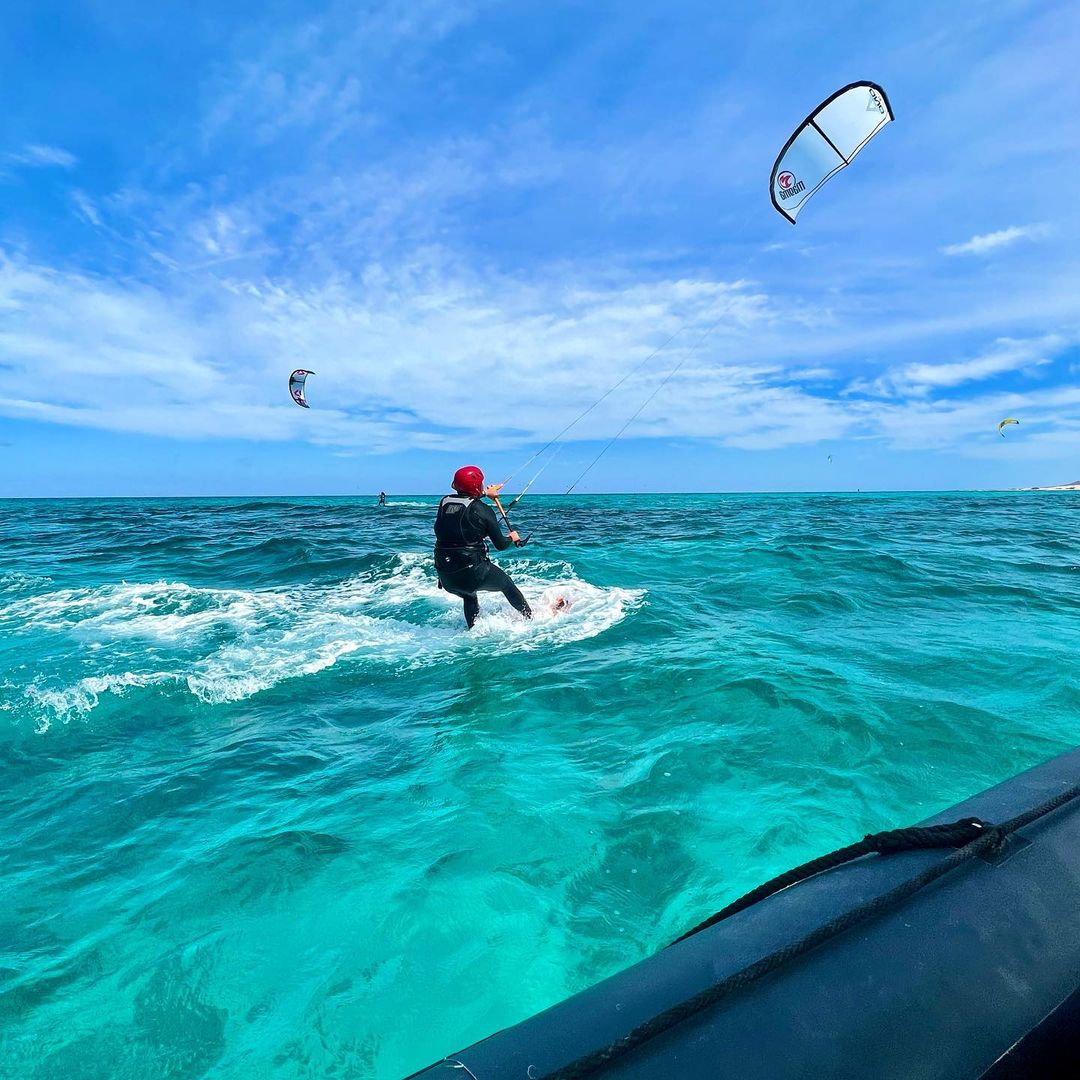
- Experiment with different bar positions to adjust the kite's power. Pulling more on the bar increases power and traction. Slightly loosening the bar unloads the power.
- Practise flying the kite in variable wind conditions. Learn to adapt your flying to the strength and direction of the wind. Anticipate gusts and changes of direction to maintain precise control of the kite.
- Explore different navigation trajectories, such as upwind, crosswind and downwind. Experiment with the rudder adjustments needed to maintain a stable, fluid trajectory.
- Practise transitioning between different trajectories by using the movements of the bar and adjusting your position on the board. Learn how to transition smoothly from one heading to another while maintaining control of the kite.
- Pay attention to the rules of priority on the water and respect other kiteboarders. Keep a safe distance and communicate your intentions using the appropriate communication signals.
- As you develop your kite-flying skills, you'll be able to confidently navigate different courses and perform more advanced manoeuvres. Continue to train regularly and explore new techniques to enrich your kiteboarding experience.
Level 4: Upwind
The ability to ride upwind is an essential skill in kitesurfing. It allows you to ride efficiently upwind and explore more remote areas. Learning to ride upwind will open up new possibilities for exploration and discovery during your kitesurfing sessions.
Upwind in a nutshell:
- Have sufficient sail area
- Start by picking up speed as you go downwind, before gradually coming back upwind, resisting the pull of the sail.
- Don't over-board your sail, let it breathe at the edge of the window.
- Avoid looking at your sail too much, pilot it using the sensations felt in your arms and harness.
- Look where you want to go: in most extreme sports, your gaze influences the position of your body and, by definition, where it will take you.
Step by step
- When you want to climb upwind, start by positioning yourself slightly to one side of the wind direction. Hold the wing at 45 degrees above you and generate enough power to start your climb.
- Use the bar control to steer the wing progressively towards the flight window, positioning it higher and closer to the vertical. This will allow you to maximise the power of the kite as you climb upwind.
- Tilt your board slightly into the wind to create lift and facilitate your progress. Keep your legs bent and your weight centred on the board to maintain balance and stability.
- Try to take a zigzag path upwind, making successive diagonal turns. Look for the optimum angle to make the most of the kite's power while progressing against the wind.
- Be patient and persevere as you climb upwind. It may be necessary to make several turns to reach your destination, constantly adjusting the angle of the kite and your position on the board.
- Bear in mind that riding upwind requires a good command of the kite and coordination between your movements and those of the kite. Keep practising regularly to improve your technique and your ability to climb upwind.
- Remember to always respect the rules of priority on the water and to keep a safe distance from other kiteboarders.
- By perfecting your upwind ability, you'll be able to sail more freely and explore new destinations during your kitesurfing sessions. Keep practising and developing your technique to take full advantage of that feeling of freedom and control on the water.
How do you go fast kiting?
To sail with maximum speed, you'll need to be well rigged, or don't hesitate to ‘work’ your kite in sinusoids to generate power (each kite movement generates power). Finally, it's important to adopt the right trajectory when going upwind, by orienting the board correctly.
Kitesurfing lessons
There are many options for learning to kitesurf, but group or private lessons with a qualified instructor are often the most effective for beginners. You can find local kitesurfing schools by searching online or asking friends who are already kitesurfing.
Kitesurfing courses usually include theoretical training on the different techniques of kite flying, as well as practical sessions in the sea or shallow water. Instructors will guide you through the learning process and provide advice on safety and kitesurfing.
Regular practice
As with any newly learnt sport, regular practice is essential to improve your kitesurfing skills. The more you practise, the more confident you'll become in your abilities and the more you'll be able to explore new techniques and challenges.
In conclusion, kitesurfing is an exciting and rewarding activity that can be learnt at any age. By following the steps outlined in this guide, you can learn to kitesurf safely and effectively. So why not get started today?
The best destinations for learning to kitesurf?
Fuerteventura, Canary Islands: This is a popular kitesurfing destination and offers a variety of options to suit all budgets, from luxury hotels to hostels, kitecamps and family flats. Discover different types of kitesurfing holidays close to the best kitesurfing spots, from Corralejo to El Cotillo and Sotavento.


